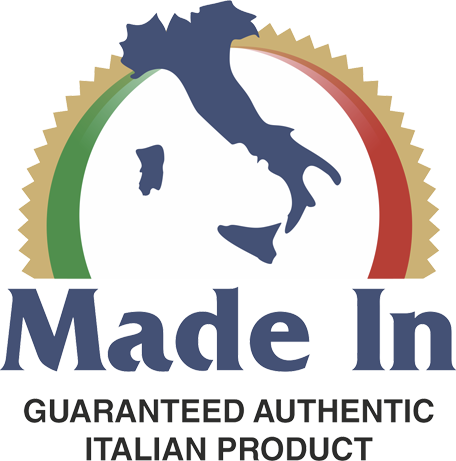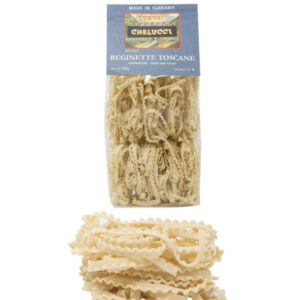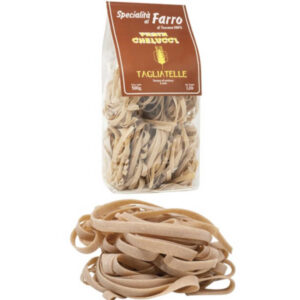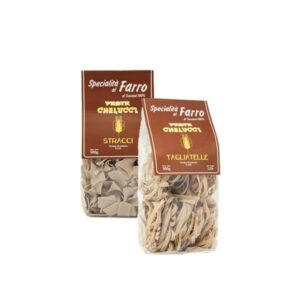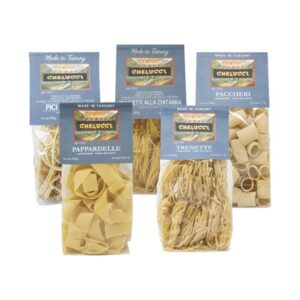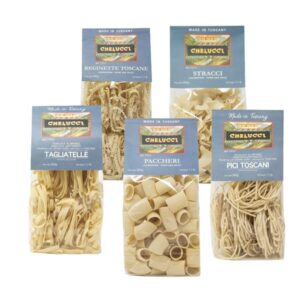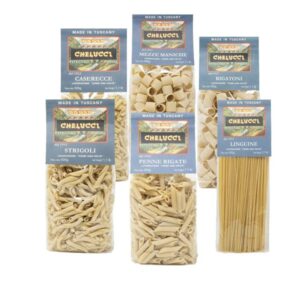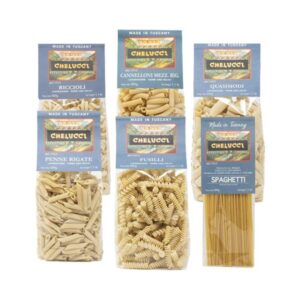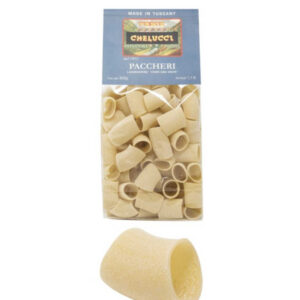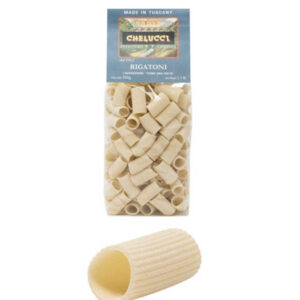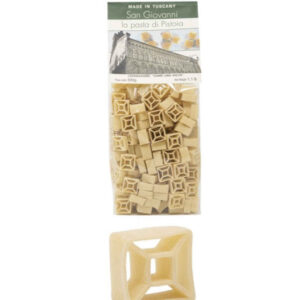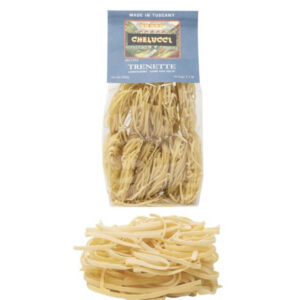-
STRACCI TUSCAN SPELT
STRACCI- TUSCAN SPELT
STRACCI TUSCAN SPELT
The pasta is sold in cartons of 10 Stracci packs of 500g = 5KgThe Stracci of Tuscan spelt from the Chelucci Pastificio is a 100% Tuscan spelt pasta from Garfagnana at Km0 (zero miles);
dried at low temperature, to fully preserve all the nutritional properties of the wheat.
The pasta is bronze drawn to give it a rough and porous consistency which improves the quality, especially of the spelt.
Its production is completely artisanal following the Tuscan tradition from the selection of the spelt to the packaging.39,00€ + VATSTRACCI TUSCAN SPELT
39,00€ + VAT -
TAGLIATELLE STRACCI TUSCAN SPELT
TAGLIATELLE STRACCI- TUSCAN SPELT – PACKAGE-08
TAGLIATELLE STRACCI of TUSCAN SPELT
The pasta is sold in cartons of 10 tagliatelle and stracci packs of 500g = 5KgThe package of high quality durum wheat semolina pasta tagliatele and stracci is composed of:
- 93F Stracci Farro x 5 pack. 500gr
- 118F Tagliatelle Farro x 5 pack. 500gr
The Tagliatelle and stracci of Tuscan spelt from the Chelucci Pastificio is a 100% Tuscan spelt pasta from Garfagnana at Km0 (zero miles);
dried at low temperature, to fully preserve all the nutritional properties of the wheat.
The pasta is bronze drawn to give it a rough and porous consistency which improves the quality, especially of the spelt.
Its production is completely artisanal following the Tuscan tradition from the selection of the spelt to the packaging.46,90€ + VATTAGLIATELLE STRACCI TUSCAN SPELT
46,90€ + VAT -
PACCHERI PICI STELLA PAPPARDELLE… PACKAGE-07
PICI STELLA PACCHERI PAPPARDELLE TRENETTE – PACKAGE-06
OF TUSCAN DURUM WHEAT
PICI STELLA PACCHERI PAPPARDELLE TRENETTE TOSCANE OF TUSCAN DURUM WHEAT
The pasta is sold in cartons of 10 Pici stella paccheri pappardelle trenette toscane packs of 500g = 5KgThe package of high quality durum wheat semolina pasta Pici stella paccheri pappardelle trenette toscane is composed of:
- 21 Pici Stella x 2 pack. 500gr
- 106 Paccheri x 2 pack. 500gr
- 016 Pappardelle x 2 pack. 350 gr
- 109 Trenette x 2 pack. 500 gr
The pasta of Tuscan durum wheat from Pastificio Chelucci is a 100% Tuscan durum wheat semolina pasta at Km0(Zero miles);
dried at low temperature, to fully preserve all the nutritional properties of the wheat.
The pasta is bronze drawn to give it a rough and porous texture which improves its quality.
Its production is completely handcrafted following the Tuscan tradition from the selection of raw materials to packaging.34,40€ + VATPACCHERI PICI STELLA PAPPARDELLE… PACKAGE-07
34,40€ + VAT -
PACCHERI PICI TOSCANI TAGLIATELLE.. PACKAGE-06
PICI TOSCANI TAGLIATELLE PACCHERI STRACCI REGINETTE TOSCANE – PACKAGE-06
OF TUSCAN DURUM WHEAT
PICI TOSCANI TAGLIATELLE PACCHERI STRACCI REGINETTE TOSCANE OF TUSCAN DURUM WHEAT
The pasta is sold in cartons of 10 Pici toscani tagliatelle stracci reginette toscane packs of 500g = 5KgThe package of high quality durum wheat semolina pasta cannelloni riccioli quasimodi penne rigate fusilli and spaghetti is composed of:
- 13 Reginette Toscane x 2 pack. 500gr
- 118 Tagliatelle x 2 pack. 500gr
- 120 Pici Toscani x 2 pack. 500gr
- 106 Paccheri x 2 pack. 500gr
- 093 Stracci x 2 pack. 500gr
The pasta of Tuscan durum wheat from Pastificio Chelucci is a 100% Tuscan durum wheat semolina pasta at Km0(Zero miles);
dried at low temperature, to fully preserve all the nutritional properties of the wheat.
The pasta is bronze drawn to give it a rough and porous texture which improves its quality.
Its production is completely handcrafted following the Tuscan tradition from the selection of raw materials to packaging.31,00€ + VATPACCHERI PICI TOSCANI TAGLIATELLE.. PACKAGE-06
31,00€ + VAT -
STRIGOLI RIGATONI CASERECCE.. PACKAGE-05
RIGATONI MEZZE MANICHE CASERECCE STRIGOLI PENNE LINGUINE – PACKAGE-05
OF TUSCAN DURUM WHEAT
RIGATONI MEZZE MANICHE CASERECCE STRIGOLI PENNE LINGUINE OF TUSCAN DURUM WHEAT
The pasta is sold in cartons of 12 Strigoli rigatoni caserecce penne rigate e linguine packs of 500g = 6KgThe package of high quality durum wheat semolina pasta cannelloni riccioli quasimodi penne rigate fusilli and spaghetti is composed of:
- 73 Mezze Maniche x 2 pack. 500gr
- 089 Caserecce x 2 pack. 500gr
- 074 Rigatoni x 2 pack. 500gr
- 096 Strigoli x 2 pack. 500gr
- 087 Penne Rigate x 2 pack. 500gr
- 013 Linguine x 2 pack. 500gr
The pasta of Tuscan durum wheat from Pastificio Chelucci is a 100% Tuscan durum wheat semolina pasta at Km0(Zero miles);
dried at low temperature, to fully preserve all the nutritional properties of the wheat.
The pasta is bronze drawn to give it a rough and porous texture which improves its quality.
Its production is completely handcrafted following the Tuscan tradition from the selection of raw materials to packaging.30,00€ + VATSTRIGOLI RIGATONI CASERECCE.. PACKAGE-05
30,00€ + VAT -
RICCIOLI PENNE CANNELLONI SPAGHETTI.. PACKAGE-04
RICCIOLI CANNELLONI PENNE RIGATE FUSILLI SPAGHETTI QUASIMODI – PACKAGE-04
OF TUSCAN DURUM WHEAT
CANNELLONI RICCIOLI PENNE RIGATE FUSILLI SPAGHETTI QUASIMODI OF TUSCAN DURUM WHEAT
The pasta is sold in cartons of 12 cannelloni riccioli quasimodi penne rigate fusilli e spaghetti packs of 500g = 6KgThe package of high quality durum wheat semolina pasta cannelloni riccioli quasimodi penne rigate fusilli and spaghetti is composed of:
- 063 Cannelloni mezzani Rigati x 2 pack. 500gr
- 090 Riccioli x 2 conf. 500gr
- 094 Quasimodi x 2 pack. 500gr
- 087 Penne Rigate x 2 pack. 500gr
- 095 Fusilli x 2 pack. 500gr
- 005 Spaghetti x 2 pack. 500gr
The pasta of Tuscan durum wheat from Pastificio Chelucci is a 100% Tuscan durum wheat semolina pasta at Km0(Zero miles);
dried at low temperature, to fully preserve all the nutritional properties of the wheat.
The pasta is bronze drawn to give it a rough and porous texture which improves its quality.
Its production is completely handcrafted following the Tuscan tradition from the selection of raw materials to packaging.30,00€ + VATRICCIOLI PENNE CANNELLONI SPAGHETTI.. PACKAGE-04
30,00€ + VAT -
PACCHERI TUSCAN DURUM WHEAT
PACCHERI – TUSCAN DURUM WHEAT
PACCHERI TUSCAN DURUM WHEAT
The pasta is sold in cartons of 10 paccheri packs of 500g = 5KgThe Paccheri of Tuscan durum wheat from Pastificio Chelucci is a 100% Tuscan durum wheat semolina pasta at Km0(Zero miles);
dried at low temperature, to fully preserve all the nutritional properties of the wheat.
The pasta is bronze drawn to give it a rough and porous texture which improves its quality.
Its production is completely handcrafted following the Tuscan tradition from the selection of raw materials to packaging.31,00€ + VATPACCHERI TUSCAN DURUM WHEAT
31,00€ + VAT -
RIGATONI TUSCAN DURUM WHEAT
RIGATONI – TUSCAN DURUM WHEAT
RIGATONI TUSCAN DURUM WHEAT
The pasta is sold in cartons of 12 rigatoni packs of 500g = 6KgThe Rigatoni of Tuscan durum wheat from Pastificio Chelucci is a 100% Tuscan durum wheat semolina pasta at Km0(Zero miles);
dried at low temperature, to fully preserve all the nutritional properties of the wheat.
The pasta is bronze drawn to give it a rough and porous texture which improves its quality.
Its production is completely handcrafted following the Tuscan tradition from the selection of raw materials to packaging.30,00€ + VATRIGATONI TUSCAN DURUM WHEAT
30,00€ + VAT -
SAN GIOVANNI PISTOIA
SAN GIOVANNI PISTOIA – TUSCAN DURUM WHEAT
SAN GIOVANNI PISTOIA TUSCAN DURUM WHEAT
The pasta is sold in cartons of 12 San giovanni Pistoia packs of 500g = 6KgThe San Giovanni Pistoia of Tuscan durum wheat from Pastificio Chelucci is a 100% Tuscan durum wheat semolina pasta at Km0(Zero miles);
dried at low temperature, to fully preserve all the nutritional properties of the wheat.
The pasta is bronze drawn to give it a rough and porous texture which improves its quality.
Its production is completely handcrafted following the Tuscan tradition from the selection of raw materials to packaging.37,20€ + VATSAN GIOVANNI PISTOIA
37,20€ + VAT -
QUASIMODI TUSCAN DURUM WHEAT
QUASIMODI – TUSCAN DURUM WHEAT
QUASIMODI TUSCAN DURUM WHEAT
The pasta is sold in cartons of 12 quasimodi packs of 500g = 6KgThe Penne rigate of Tuscan durum wheat from Pastificio Chelucci is a 100% Tuscan durum wheat semolina pasta at Km0(Zero miles);
dried at low temperature, to fully preserve all the nutritional properties of the wheat.
The pasta is bronze drawn to give it a rough and porous texture which improves its quality.
Its production is completely handcrafted following the Tuscan tradition from the selection of raw materials to packaging.30,00€ + VATQUASIMODI TUSCAN DURUM WHEAT
30,00€ + VAT -
TRENETTE TUSCAN DURUM WHEAT
TRENETTE – TUSCAN DURUM WHEAT
TRENETTE TUSCAN DURUM WHEAT
The pasta is sold in cartons of 10 trenette packs of 500g = 5KgThe Trenette of Tuscan durum wheat from Pastificio Chelucci is a 100% Tuscan durum wheat semolina pasta at Km0(Zero miles);
dried at low temperature, to fully preserve all the nutritional properties of the wheat.
The pasta is bronze drawn to give it a rough and porous texture which improves its quality.
Its production is completely handcrafted following the Tuscan tradition from the selection of raw materials to packaging.31,00€ + VATTRENETTE TUSCAN DURUM WHEAT
31,00€ + VAT -
REGINETTE TOSCANE – TUSCAN REGINETTE
REGINETTE TOSCANE – TUSCAN DURUM WHEAT
REGINETTE TOSCANE TUSCAN DURUM WHEAT
The pasta is sold in cartons of 10 Reginette packs of 500g = 5KgThe Reginette toscane of Tuscan durum wheat from Pastificio Chelucci is a 100% Tuscan durum wheat semolina pasta at Km0(Zero miles);
dried at low temperature, to fully preserve all the nutritional properties of the wheat.
The pasta is bronze drawn to give it a rough and porous texture which improves its quality.
Its production is completely handcrafted following the Tuscan tradition from the selection of raw materials to packaging.31,00€ + VATREGINETTE TOSCANE – TUSCAN REGINETTE
31,00€ + VAT
Pasta is made in Italy
It is difficult to find a more universal symbol of Italianness than pasta
Is there perhaps a more natural and simple food than pasta?
Italian durum wheat semolina and water.
No preservatives, because it is the drying of the extruded product that allows an indefinite shelf life. No dyes: looking back at a bundle of spaghetti we find the brightness of the sun absorbed by the grain of wheat and returned by the semolina. No chemical additives and not even salt.
How to recognize good pasta?
From a careful examination of the raw product we can say that we are in the presence of a good pasta if:
– the appearance is uniformly smooth and no roughness, “spots” or dark shadows appear in transparency;
– the color is a clear and unmistakable amber yellow;
– no odor is detected;
– when tasted (we are obviously always talking about a raw product) the flavor is slightly sweetish;
– the break gives a dry sound and the break appears smooth and glassy.
In most Italian regions, penne rigate is preferred, which hold the sauce more easily, while in Neapolitan recipes we find above all smooth pasta, in particular macaroni: what most distinguishes them is their golden yellow color, as well as the their granular mixture which has a particular transparency; moreover, if they break, they break unevenly and the interior appears bright.


